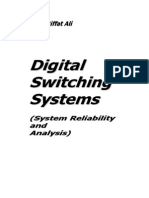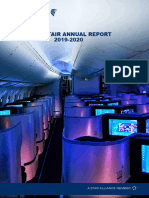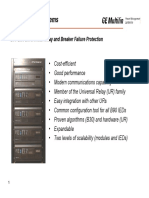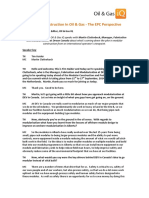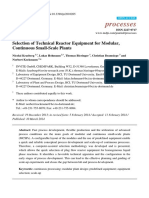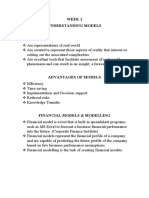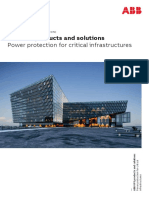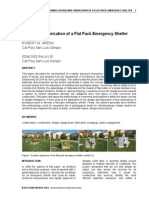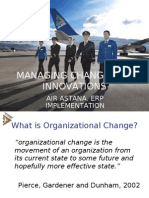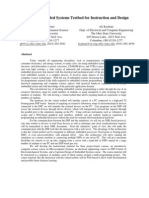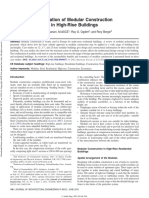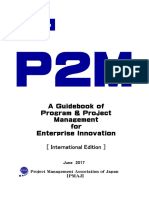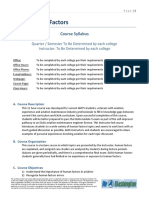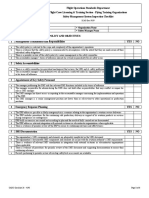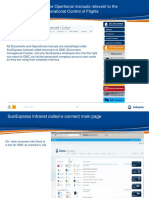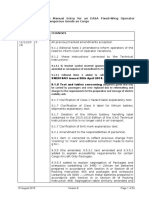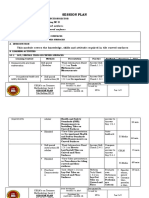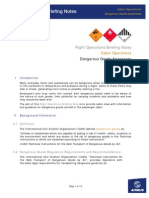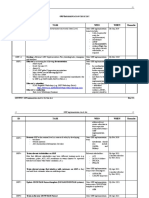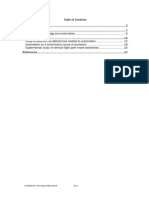User Guide: Emergency Response Planning Module
Uploaded by
bfibingierUser Guide: Emergency Response Planning Module
Uploaded by
bfibingierUSER GUIDE
Emergency Response Planning Module
Table of Contents
General Information 2
The ICAO Requirement – Safety Management System 2
Web based solution to implement SMS 2
Web Access to IQSMS 3
Emergency Response Planning Module 4
Users in the ERP Module 4
Emergency Response Planning Module 4
Main Screen of the ERP Module 5
Administrator Functions 6
1.1 Create Emergency Response 6
1.2 Edit Emergency Scenarios 8
1.3 Activate an Emergency Scenario 10
1.4 Notification Costs 11
1.5 ERP Manual Upload 11
ERP Module- User View 13
2.1 Emergency Management 13
2.2 Initiate Emergency Response 14
2.3 Closed Emergencies 16
List of Figures 17
Disclaimer 18
Version 3.65 1
General Information
The ICAO Requirement – Safety Management System
To keep safety risks at an acceptable level despite the increasing level of air traffic activity, modern
safety management practices are shifting from a reactive and basic proactive mode to a predictive
approach. The ICAO Doc. 9859 (Safety Management Manual) demands a system, which collects,
(risk) analyses and shares safety related data arising from normal operations.
Web based solution to implement SMS
IQSMS (Integrated Quality and Safety Management System) is a web-based solution to implement
SMS (Safety Management System). The software’s modular setup enables ASQS customers to
decide which modules support their company most effectively.
Figure 1: IQSMS main modules: Quality Management, Risk Management and Reporting.
All modules are feeding a common database with standardized event classifications. This way, a
predictive approach for the identification of possible overall company risks by means of risk
assessment and classification is guaranteed.
Currently, a total of 10 modules are available, with a focus on the three main modules: Quality
Management, Risk Management and Reporting.
This document will focus on the features and functionality of the Emergency Response Planning
Module. For more information about other modules, please refer to the respective user guides or
the general features list.
As IQSMS is a highly adaptable tool and ASQS strives to meet the individual needs of every
customer, many standard features can be adapted and customised to the needs of each
organisation. This might lead to some feature described in this user guide to vary from the version
actually used by your organisation. If you do encounter any ambiguity in this guide, please do not
hesitate to contact our support.
Version 3.65 2
Web Access to IQSMS
It is recommended by ASQS to use IQSMS with Internet Explorer 11 and above, Firefox, Google
Chrome and Safari letter size normal. Reports can also be entered on smart phones and Tablet
PCs. Please note that JavaScript must be enabled.
When accessing IQSMS - the login screen appears. Enter your username and password in the
indicated text fields and click on the login button. Remember that the password is case-sensitive.
Figure 2:Login Screen.
After a successful login, the User Dashboard of IQSMS appears.
Figure 3: Example of a Main Menu of IQSMS.
Version 3.65 3
Emergency Response Planning Module
This module aids your company in ensuring that there is an orderly and efficient transition from
normal to emergency operations.
The ERP Module is a proactive emergency management tool that can be used for incidents and
accidents, but also for any abnormal situation within the organisation that requires complex
decision making, centralised coordination and proper distribution of tasks. It enables the
implementation, development, maintenance and testing of emergency preparedness and response
arrangements. This module allows you to predefine a number of emergency scenarios and to
develop corresponding checklists for all relevant responsible people involved in the emergency
response process.
Its use is not only limited to incidents or accidents, but for any abnormal situation within the
organization that requires centralized coordination and proper distribution of tasks, such as AOG
situations, security threats or aircraft diversions.
Users in the ERP Module
Emergency Response Planning Module
Several different user roles can be assigned for the ERP Module. User roles are assigned by the
system administrator in the Administrator Functions.
Administrator ERP Performs administrative tasks and determines the overall settings associated with the use of
Module the ERP Module.
Can initiate an Emergency Response.
Sets up Emergency Response Plans, task lists and assigns ERP Responsibles to the
individual task lists. Can upload ERP manuals.
ERP User Can initiate an Emergency Response.
Can see ongoing and closed Emergency Responses.
Can download ERP manuals.
ERP Responsible Carries out the tasks and scenarios assigned to them by the Administrator ERP Module.
Can download ERP manuals.
Version 3.65 4
Main Screen of the ERP Module
By clicking on Emergency Response Planning Module on the IQSMS initial screen you are directed to
the main screen of the module.
On this screen, you can see the list of documents that you have been assigned to. You can also
access the Administrator Functions through Administration, if you have the corresponding used
role.
Figure 4: Main Screen
Version 3.65 5
Administrator Functions
In the administrator functions, the users with the roles Administrator ERP Module and System
Administrator can manage the existing emergency scenarios or create new scenarios. To enter the
administrator functions, select Administration- ‘Manage Emergencies’ from the main screen.
Figure 5: Administrator Functions
1.1 Create Emergency Response
Begin by entering the emergency and the description into the free text fields at the top.
Figure 6: Create Emergency Response
Version 3.65 6
To add a checklist, select the green Create Checklist button. As you are leaving the page, you will
be asked to first save your changes.
When creating a new checklist, you must assign at least one responsible. You can select them
from the drop-down menu. According to the Responsible Hierarchy, the person you will add first is
going to be the first informed, if that person does not reply in the predefined timeframe, then the
next responsible will be informed.
Figure 7: Add a checklist
To enter a task, press the green Add Task button. You can add a title and description to the task. It
is also possible to add an attachment here. If you have created multiple tasks, you can use the
arrows on the left-hand side to reorder the tasks based on hierarchal status.
Please note: You can add or remove an attachment when creating a checklist. To add
attachments, click the button „Add Attachment “. Already attached items can be removed via the
„Delete Attachment “button.
Figure 8 Add or remove attachments
Version 3.65 7
1.2 Edit Emergency Scenarios
To edit an emergency scenario, click on the scenario and a toolbar will appear, as shown in figure
7. Select Edit from the toolbar.
Figure 9: Edit Scenarios
In the top half of the screen, you can edit the title and description of the scenario.
Figure 10: Edit Scenarios 2
The lower half of the screen deals with the checklists. You can create a new checklist or work on
an existing one. To create a new one, select the green Create Checklist button.
Version 3.65 8
Figure 11: Checklists
To edit a checklist, press Edit Checklist. You will be redirected to the following screen. Here you
can edit the description and checklist name.
In the Responsible Hierarchy, you choose the responsible(s) who are assigned to the checklist. At
least one responsible must be assigned. You can define when the notification is sent out and the
method by which it is sent out.
Under Tasks, you define the procedure that must be followed. This can also include attachments.
Press Save once you have finished.
Figure 12: Edit Checklists
If you wish to delete the checklist, press delete. You will be asked to confirm the action before
proceeding.
To create a copy of the checklist, select Duplicate. This will duplicate the checklist, then you can
edit and work on it as necessary.
To view all the revisions to the checklists, press Show Revisions from the tool bar. Here you will see
an overlay showing all the changes to the document. You have the option of reverting back to
changes by choosing Restore.
Version 3.65 9
Figure 13: Checklist Revisions
Furthermore, there is the option to copy Checklist in order to copy a checklist to another scenario.
To do so, click „Copy To “and define the target scenario in the overlay menu:
Figure 14: Copy Checklist to another scenario
1.3 Activate an Emergency Scenario
Once you have saved a scenario, it will be activated automatically. To activate scenarios that have
been deleted, select Show inactive scenarios. The old scenarios will appear in the list and by
clicking on them, you will have the option to activate them.
Version 3.65 10
Figure 15: Activate Emergency Scenario
1.4 Notification Costs
This page shows the log of emergency notifications sent out and the details about each. In the
upper right-hand corner, the total ERP and QMS Notification costs are shown.
Figure 16: Notification costs
You can also export this list in an excel sheet with the button Export File.
1.5 ERP Manual Upload
You can upload or remove manuals here. Simply choose the required file and then select Upload
Manual.
Version 3.65 11
Figure 17: ERP Manual Upload
Version 3.65 12
ERP Module- User View
2.1 Emergency Management
If you have been assigned to emergency scenarios, you can manage these under Emergency
Management.
Figure 18: Emergency Management
Details of the emergency, the aircraft involved and the number of checklists and tasked needed to
be completed are shown here. Clicking on the emergency will bring up a toolbar.
Clicking on Emergency Management will bring up the page shown in figure 18. Here you can decide
on the course of action to be taken during an emergency. On the left-hand tab, you can choose
between setting up a hotline, scheduling a conference and calling the CAA.
Figure 19: Emergency Management
Version 3.65 13
2.2 Initiate Emergency Response
To initiate an emergency response, go to the corresponding page via the main menu. Select the
emergency from the drop-down list and the checklists related to that emergency will automatically
appear on the right-hand side. Further details about the emergency can be defined under
Emergency Details. The notification that the assigned responsible receives can also be written out
under Responsible Notification. Once you are ready to begin the procedure, press Start Emergency
Procedure.
Figure 20: Initiate Emergency Response
You will be asked to confirm if you want to start the procedure.
Figure 21: Emergency Procedure
Version 3.65 14
After pressing yes, you will enter the emergency procedure screen. A countdown will be triggered
in the very top right-hand corner and the page will automatically refresh at regular short intervals.
Figure 22: Starting an Emergency Procedure
The checklist status shows which notifications have been sent out to what responsibles and
whether they have already started taking action. The tasks yet to be completed are shown here
too. Below this, you can change the responsibles and add a custom notification for them to
receive.
If you wish to cancel the emergency procedure, you can do so at any time with the button at the
bottom of the screen.
Version 3.65 15
2.3 Closed Emergencies
With this button, you can view an overlay with all the closed emergencies in the system, including
details of whether they were completed or cancelled or closed.
Figure 23: Closed Emergencies
To print a PDF of a closed emergency, select the necessary scenario and the toolbar will appear,
with the Print button.
Figure 24: Print Closed Emergencies
Version 3.65 16
List of Figures
Figure 1: IQSMS main modules: Quality Management, Risk Management and Reporting. .......................... 2
Figure 2:Login Screen. ......................................................................................................................... 3
Figure 3: Example of a Main Menu of IQSMS. ........................................................................................ 3
Figure 4: Main Screen ......................................................................................................................... 5
Figure 5: Administrator Functions ........................................................................................................ 6
Figure 6: Create Emergency Response .................................................................................................. 6
Figure 7: Add a checklist ...................................................................................................................... 7
Figure 8 Add or remove attachments.................................................................................................... 7
Figure 9: Edit Scenarios ....................................................................................................................... 8
Figure 10: Edit Scenarios 2 ................................................................................................................... 8
Figure 11: Checklists ........................................................................................................................... 9
Figure 12: Edit Checklists ..................................................................................................................... 9
Figure 13: Checklist Revisions ............................................................................................................ 10
Figure 14: Copy Checklist to another scenario ..................................................................................... 10
Figure 15: Activate Emergency Scenario.............................................................................................. 11
Figure 16: Notification costs .............................................................................................................. 11
Figure 17: ERP Manual Upload ........................................................................................................... 12
Figure 18: Emergency Management ................................................................................................... 13
Figure 19: Emergency Management ................................................................................................... 13
Figure 20: Initiate Emergency Response .............................................................................................. 14
Figure 21: Emergency Procedure ........................................................................................................ 14
Figure 22: Starting an Emergency Procedure ....................................................................................... 15
Figure 23: Closed Emergencies ........................................................................................................... 16
Figure 24: Print Closed Emergencies ................................................................................................... 16
Version 3.65 17
© Aviation Safety and Quality Solutions S.à r.L.
Disclaimer
All rights reserved. No part of this publication may be reproduced, stored in a retrieval system, or
transmitted in any form or by any means, electronic, mechanical, photocopying, recording, or
otherwise, without prior written permission of Aviation Safety & Quality Solutions S.à r.L.
The information contained in this document is general in nature and provided as reference
material only. Although we aim to work with the highest levels of accuracy, we cannot guarantee
that there are no spelling errors or minor inaccuracies in this document. If you do encounter any
problems with the content of this document, please contact the ASQS Support (see below).
This user guide describes the use of the IQSMS version 3.65. The current IQSMS version number
can be identified by clicking on the icon in the upper part of the screen.
Support
The ASQS team is dedicated to provide comprehensive support to users of the program. This
includes not only problem solving and bug-fixes, but also general assistance to facilitate the use of
the program.
In case you encounter any problems while using the program, please first refer to the IQSMS User
Guide. If the available documentation does not adequately address your problem, please contact
ASQS Support via e-mail: [email protected] anytime, and expect a reply within the next business
day.
Credits
The IQSMS software was created by Aviation Safety & Quality Solutions S.à r.L, Luxembourg.
Gender Disclaimer
To ensure best readability, we use a generic masculine form throughout this document. It does
however refer equally to both sexes.
Version 3.65 18
You might also like
- Scientific American Special Collector's Edition - Winter 2022100% (8)Scientific American Special Collector's Edition - Winter 2022128 pages
- cabin-safety-supervisory-personnel-guideNo ratings yetcabin-safety-supervisory-personnel-guide12 pages
- EASA BASELINE EBT CHECKLIST V1.2 Dated 25.07.2022No ratings yetEASA BASELINE EBT CHECKLIST V1.2 Dated 25.07.202251 pages
- SPI Company Presentation November 2014 101114100% (1)SPI Company Presentation November 2014 10111438 pages
- Industrial Systems: B90 Bus Differential Relay and Breaker Failure ProtectionNo ratings yetIndustrial Systems: B90 Bus Differential Relay and Breaker Failure Protection71 pages
- AC 121-32A Dispatch Resource Management Training0% (1)AC 121-32A Dispatch Resource Management Training14 pages
- Modular Construction in Oil & Gas - The EPC PerspectiveNo ratings yetModular Construction in Oil & Gas - The EPC Perspective3 pages
- Safety Management System (SMS) : FundamentalsNo ratings yetSafety Management System (SMS) : Fundamentals26 pages
- Jetstar ISAGO Audit Checklist - SafetyCultureNo ratings yetJetstar ISAGO Audit Checklist - SafetyCulture74 pages
- Robert Arens VERSIONING - Design and Fabrication of A Flat Pack Emergency ShelterNo ratings yetRobert Arens VERSIONING - Design and Fabrication of A Flat Pack Emergency Shelter8 pages
- Mdca-Ac-Aw006 Foreign Amo Certification Rev 1No ratings yetMdca-Ac-Aw006 Foreign Amo Certification Rev 112 pages
- The Efficiency of The Teachers of Colegio de San Jose in Manually Checking The Self Learning Modules of The Students in The Modular Learning ModalityNo ratings yetThe Efficiency of The Teachers of Colegio de San Jose in Manually Checking The Self Learning Modules of The Students in The Modular Learning Modality3 pages
- 4system Integration and Architecture 1 Midterm Quiz 1No ratings yet4system Integration and Architecture 1 Midterm Quiz 111 pages
- Airline-Emergency-Response-Gap-Analysis-Checklist 2No ratings yetAirline-Emergency-Response-Gap-Analysis-Checklist 211 pages
- AHM 176A Acceptance and Carriage of Passengers With Reduced MobilityNo ratings yetAHM 176A Acceptance and Carriage of Passengers With Reduced Mobility8 pages
- A Guidebook of Program & Project Management For Enterprise Innovation International EditionNo ratings yetA Guidebook of Program & Project Management For Enterprise Innovation International Edition50 pages
- FS2Crew Flight Crew A320 Main Ops ManualNo ratings yetFS2Crew Flight Crew A320 Main Ops Manual14 pages
- Ac 91-13 Guidelines For The Approval and Use of Electronic Flight Bag EFB DevicesNo ratings yetAc 91-13 Guidelines For The Approval and Use of Electronic Flight Bag EFB Devices52 pages
- Legal Education Reform Pursuits in Ethiopia: Attainments and Challenges (2006-2019)No ratings yetLegal Education Reform Pursuits in Ethiopia: Attainments and Challenges (2006-2019)51 pages
- Polab AMT Laboratory Automation System With Industrial RobotNo ratings yetPolab AMT Laboratory Automation System With Industrial Robot2 pages
- Computer Applications (40-Assignment) : Product Fact SheetNo ratings yetComputer Applications (40-Assignment) : Product Fact Sheet2 pages
- (PTRL14H03) Model Answer Reservoir Management100% (1)(PTRL14H03) Model Answer Reservoir Management9 pages
- Guidance For Occurrence Reporting in Aviation: ContentNo ratings yetGuidance For Occurrence Reporting in Aviation: Content10 pages
- 159 Contents of The Operations Manual Relevant To The Operational Control of FlightsNo ratings yet159 Contents of The Operations Manual Relevant To The Operational Control of Flights15 pages
- CAP720 - Flight Crew Training - CRM and LOFTNo ratings yetCAP720 - Flight Crew Training - CRM and LOFT65 pages
- 3-4 PBN Approval and Training - AustraliaNo ratings yet3-4 PBN Approval and Training - Australia42 pages
- EASA Operators With Approval To Carry Dangerous Goods As Cargo (Aeroplanes)No ratings yetEASA Operators With Approval To Carry Dangerous Goods As Cargo (Aeroplanes)52 pages
- FOBN Airbus - Cabin Operations, Dangerous Goods AwarenesNo ratings yetFOBN Airbus - Cabin Operations, Dangerous Goods Awarenes12 pages
- SQMS Basic Structure For Operators Iss2 Rev 0 20100224100% (1)SQMS Basic Structure For Operators Iss2 Rev 0 2010022453 pages
- 2020 Dangerous Goods Checklist For A Non-Radioactive ShipmentNo ratings yet2020 Dangerous Goods Checklist For A Non-Radioactive Shipment2 pages
- PLC Programming & Implementation: An Introduction to PLC Programming Methods and ApplicationsFrom EverandPLC Programming & Implementation: An Introduction to PLC Programming Methods and ApplicationsNo ratings yet











